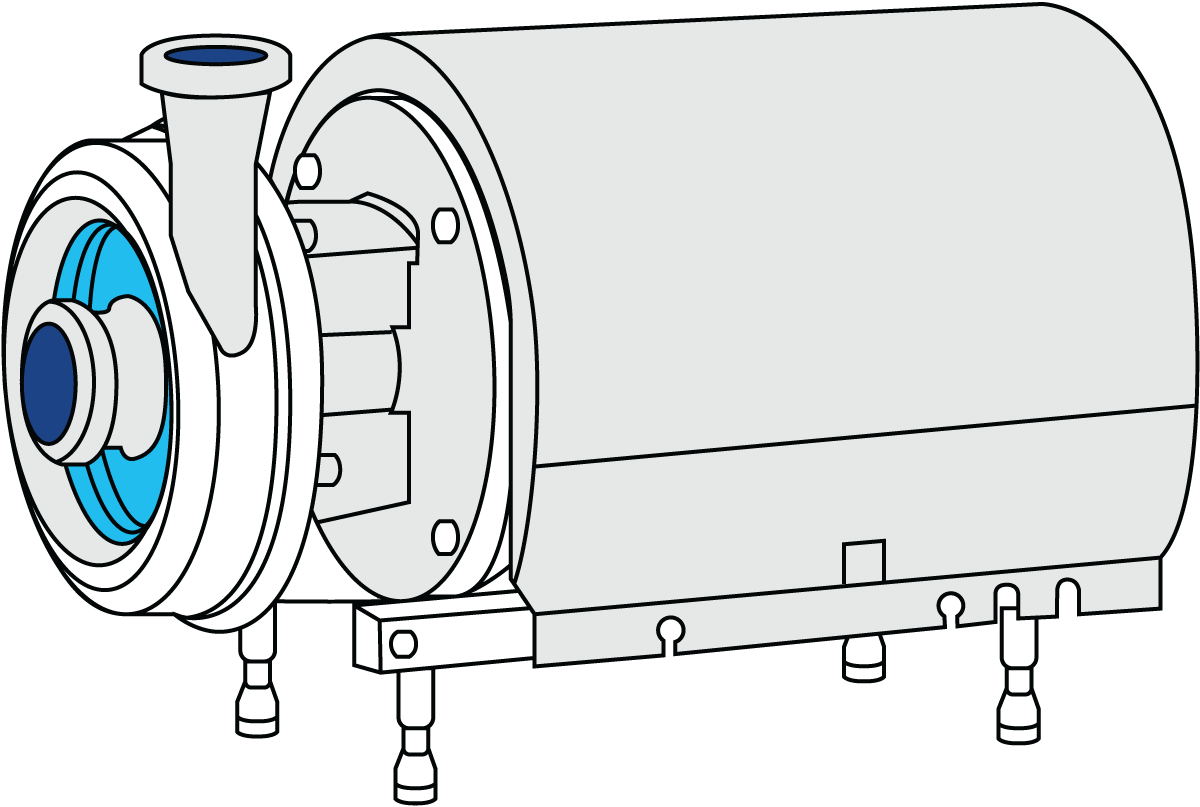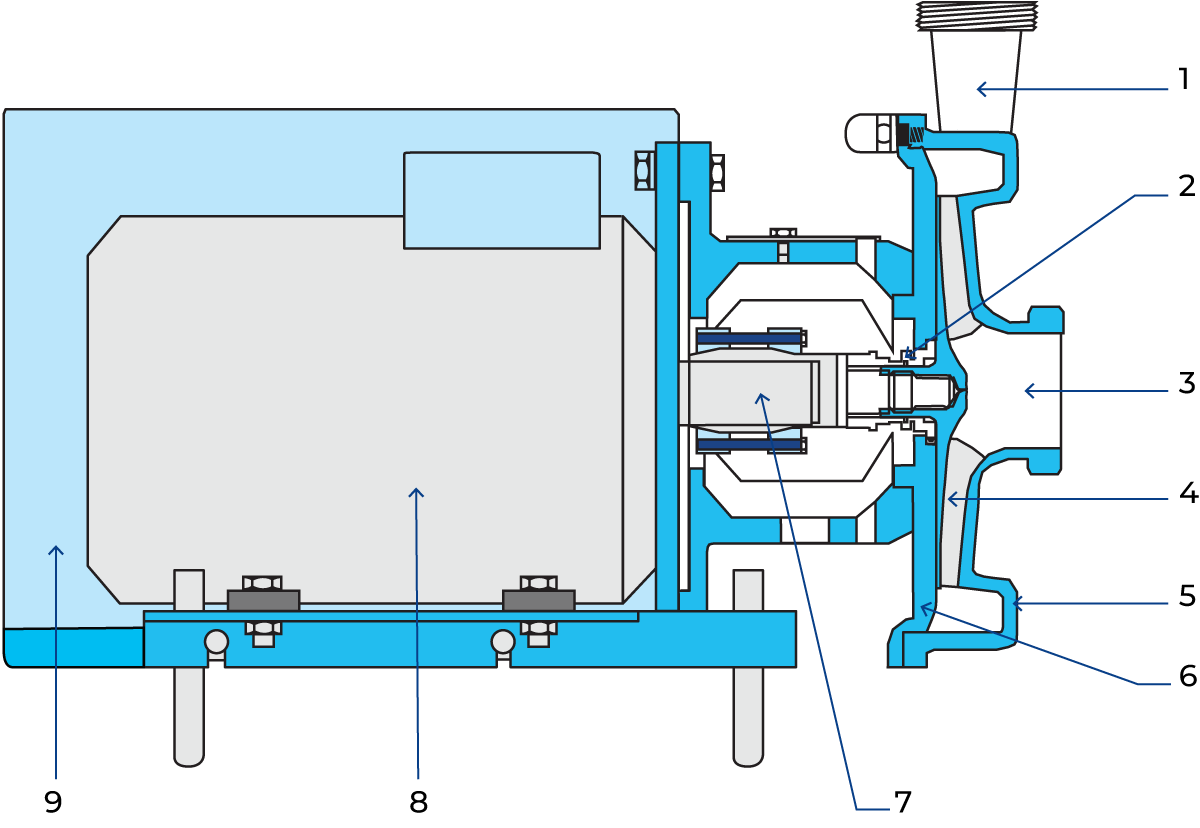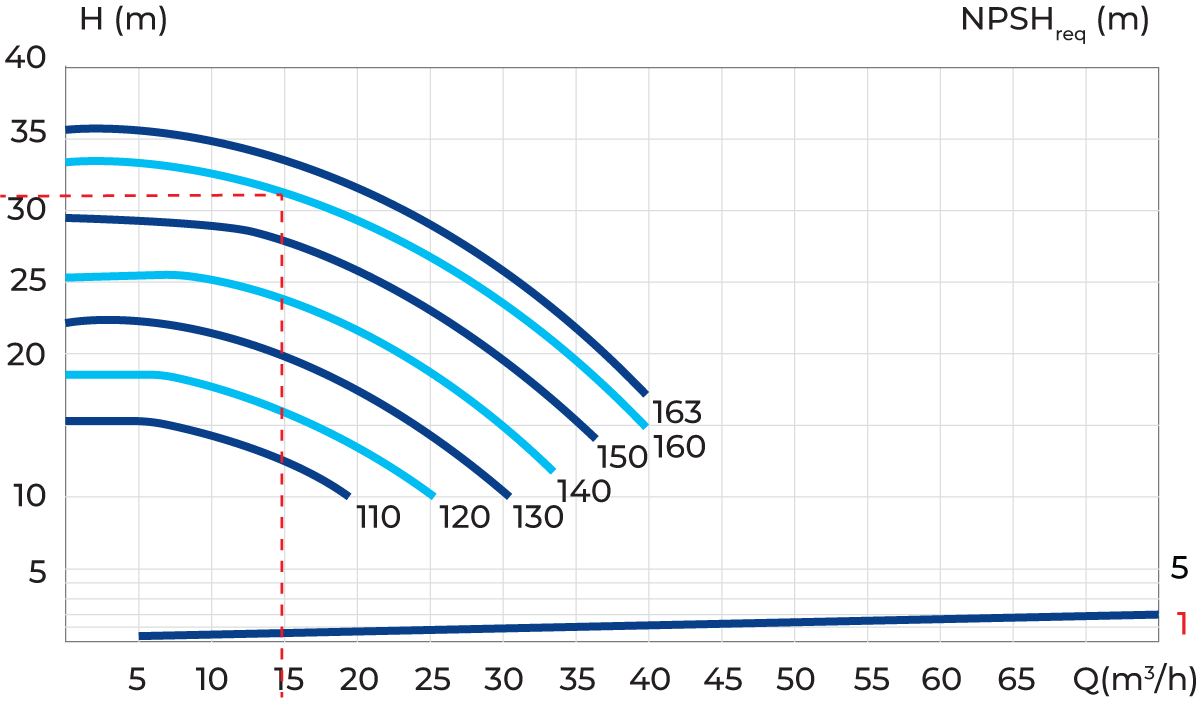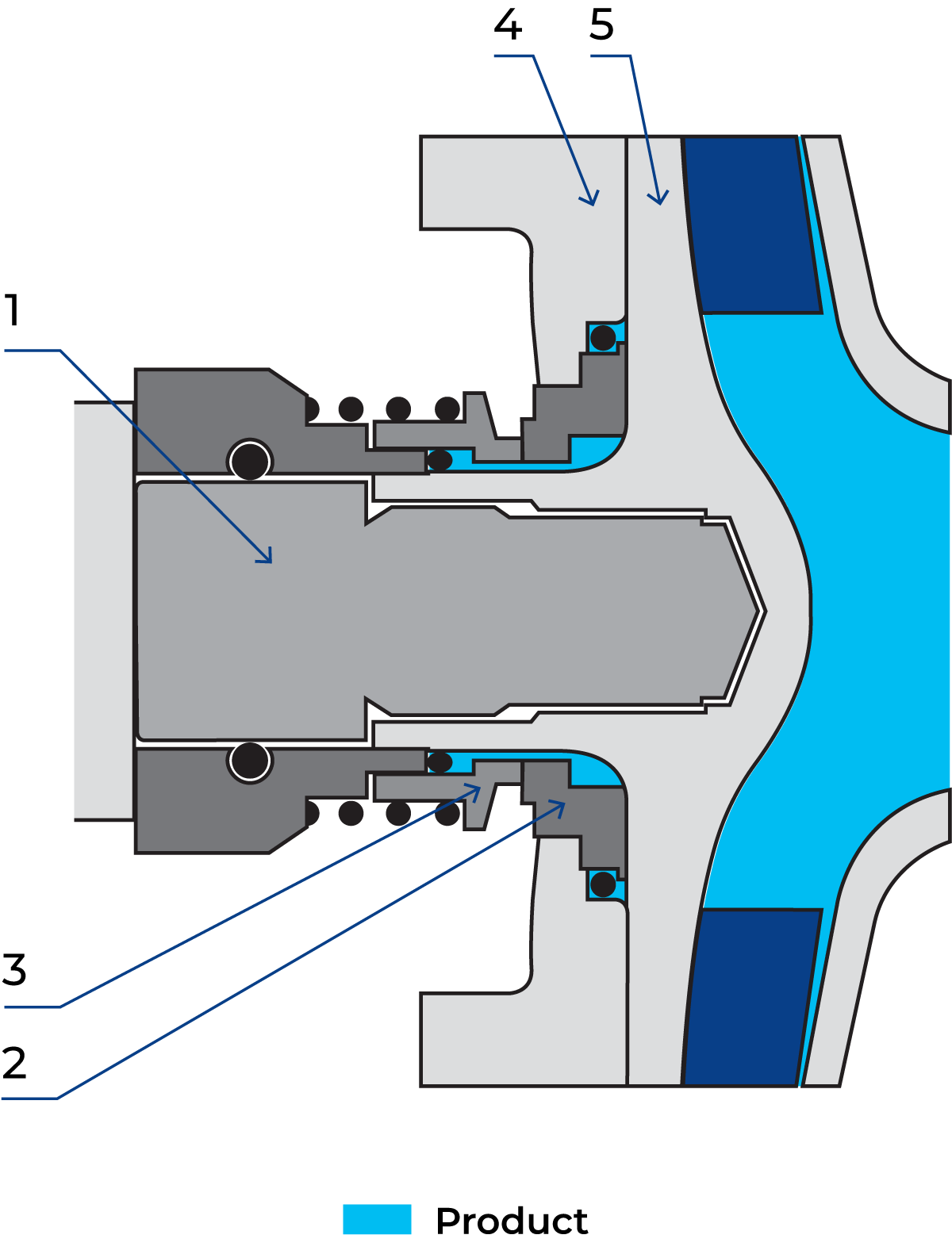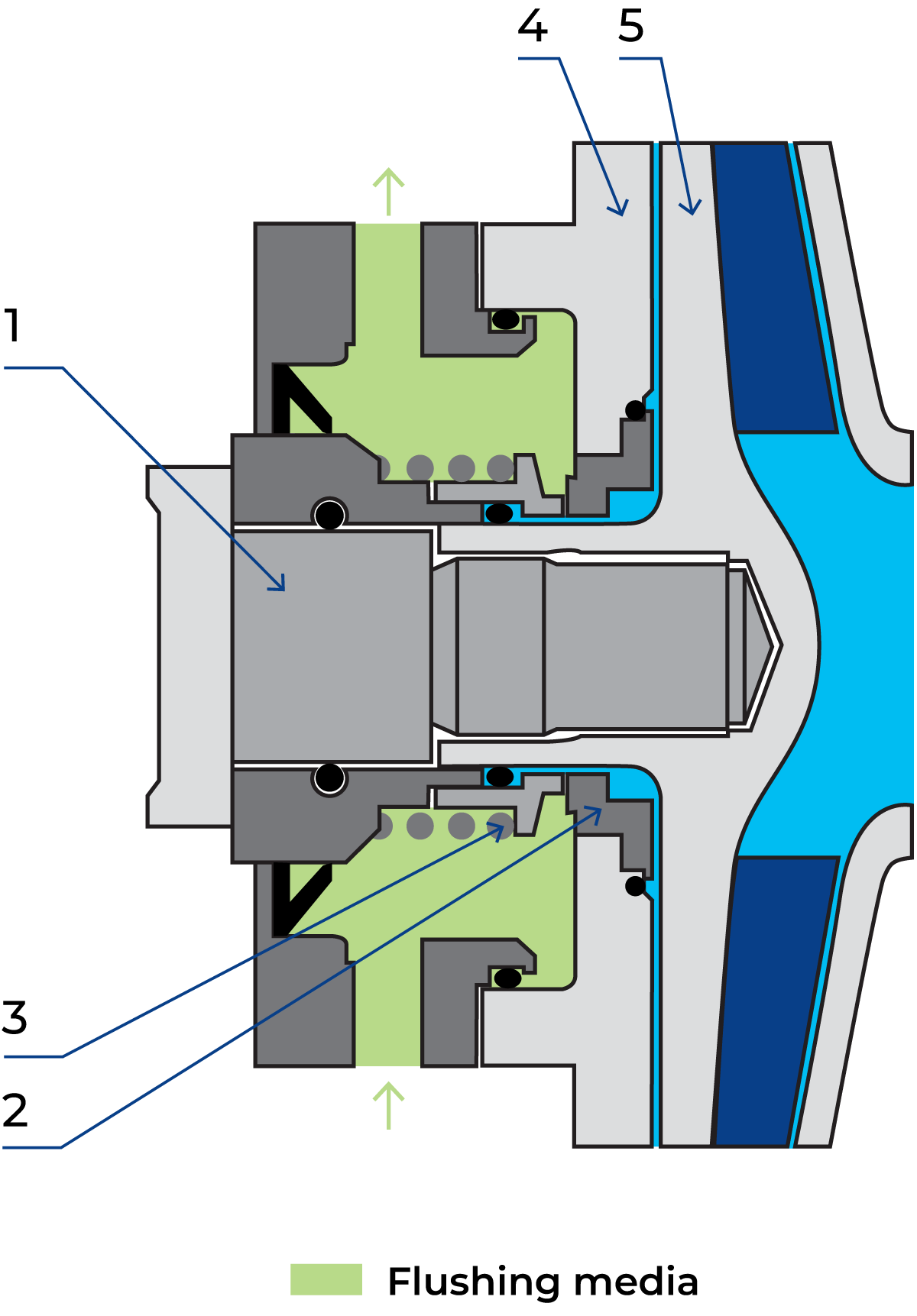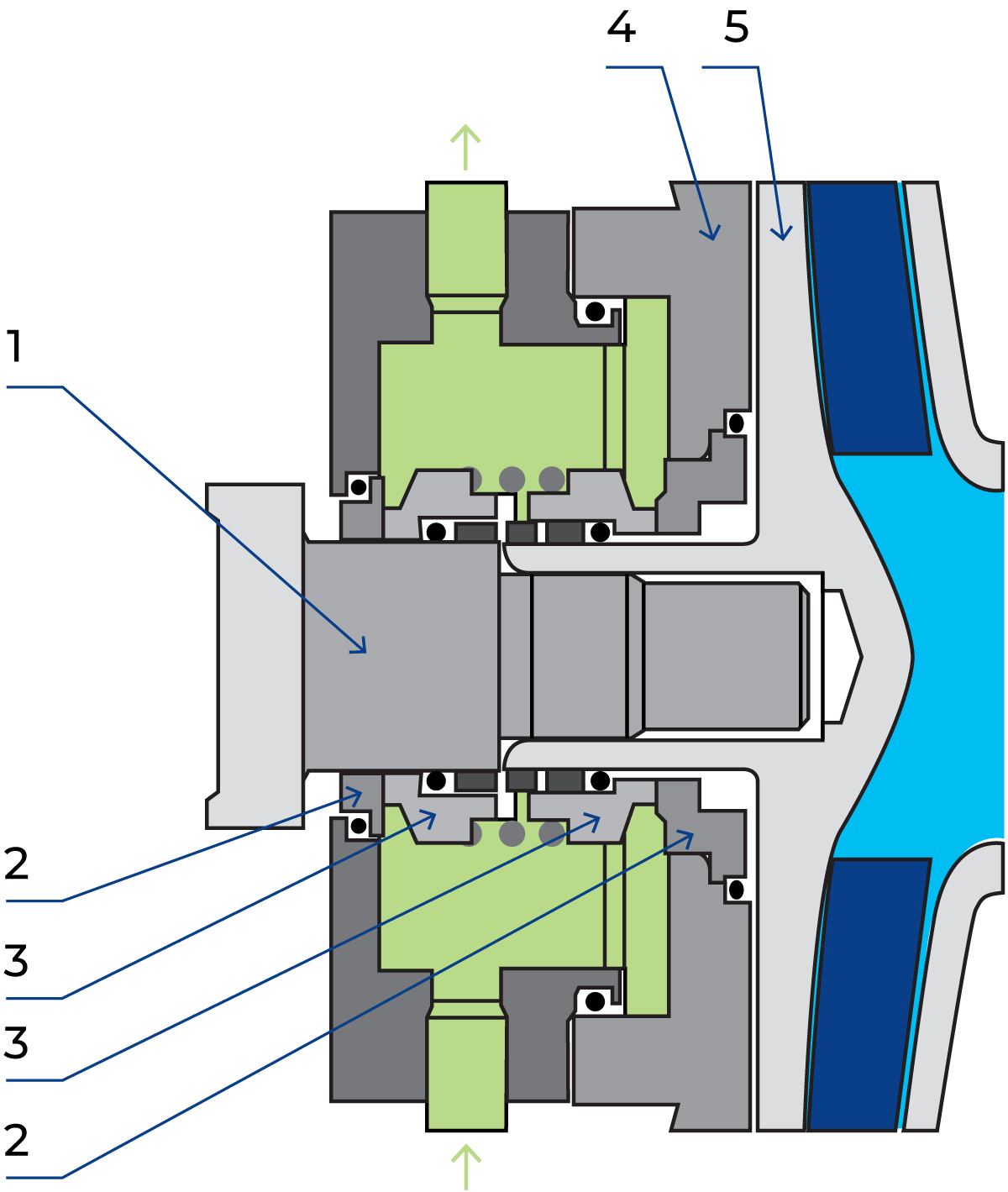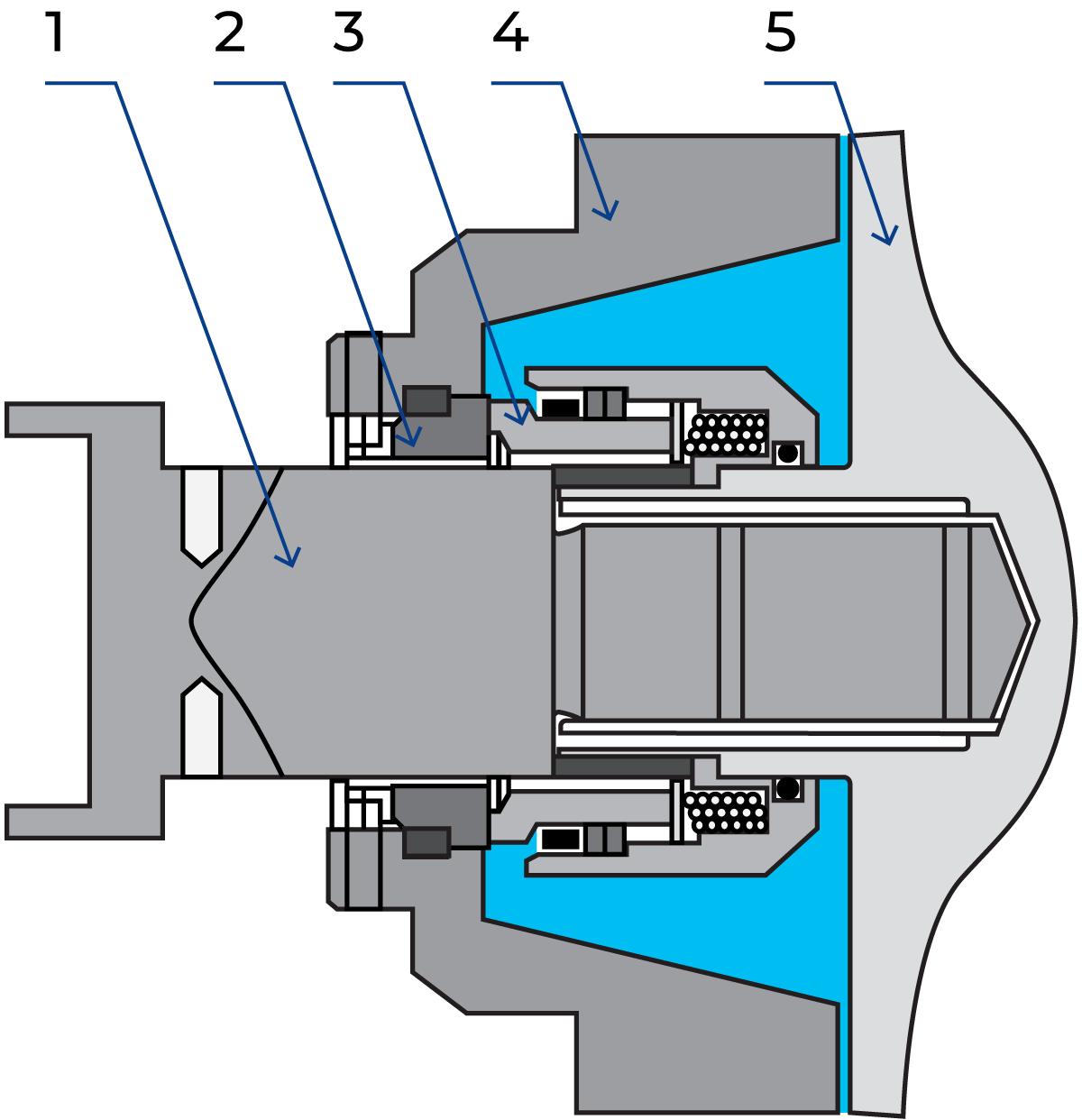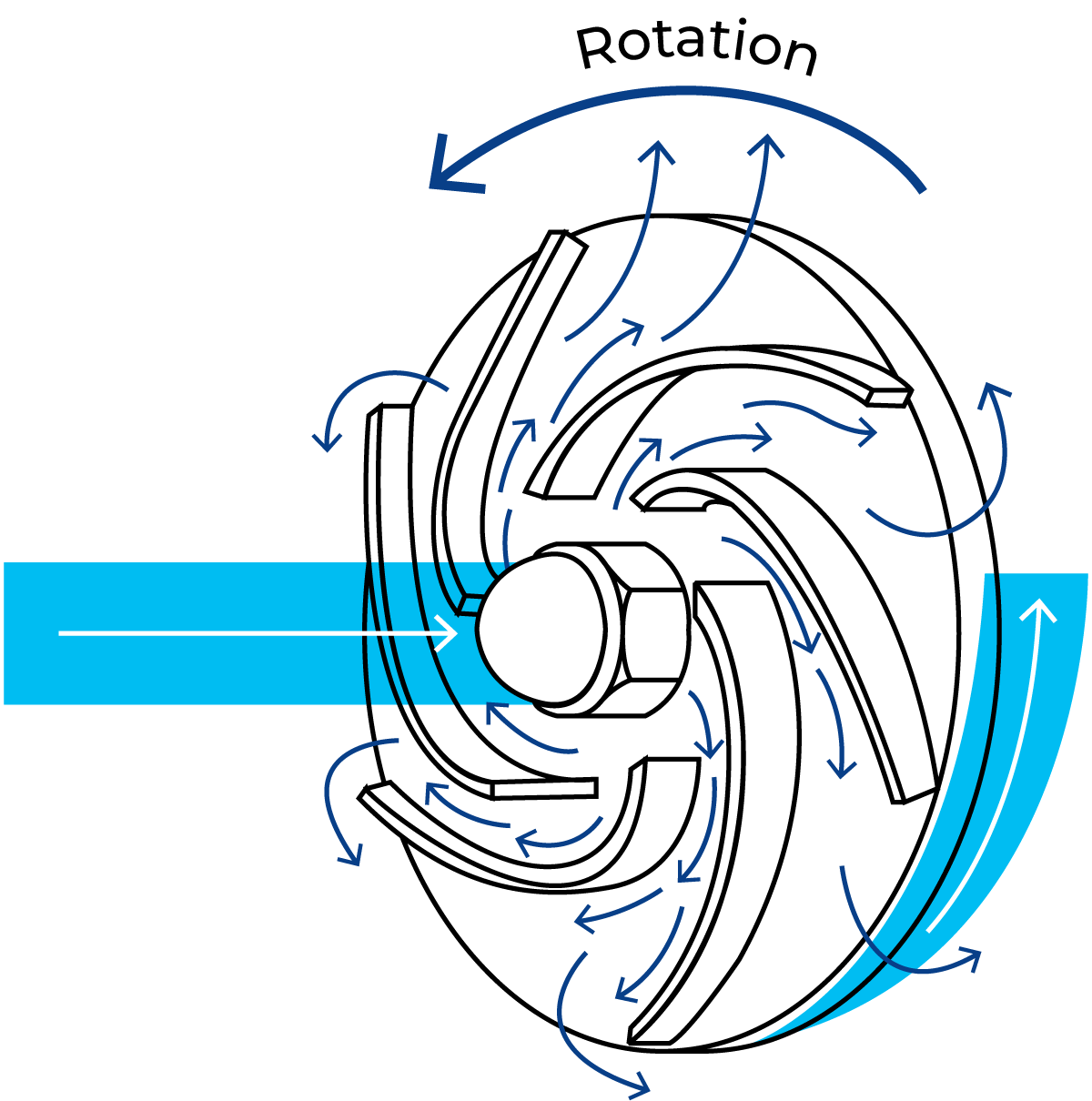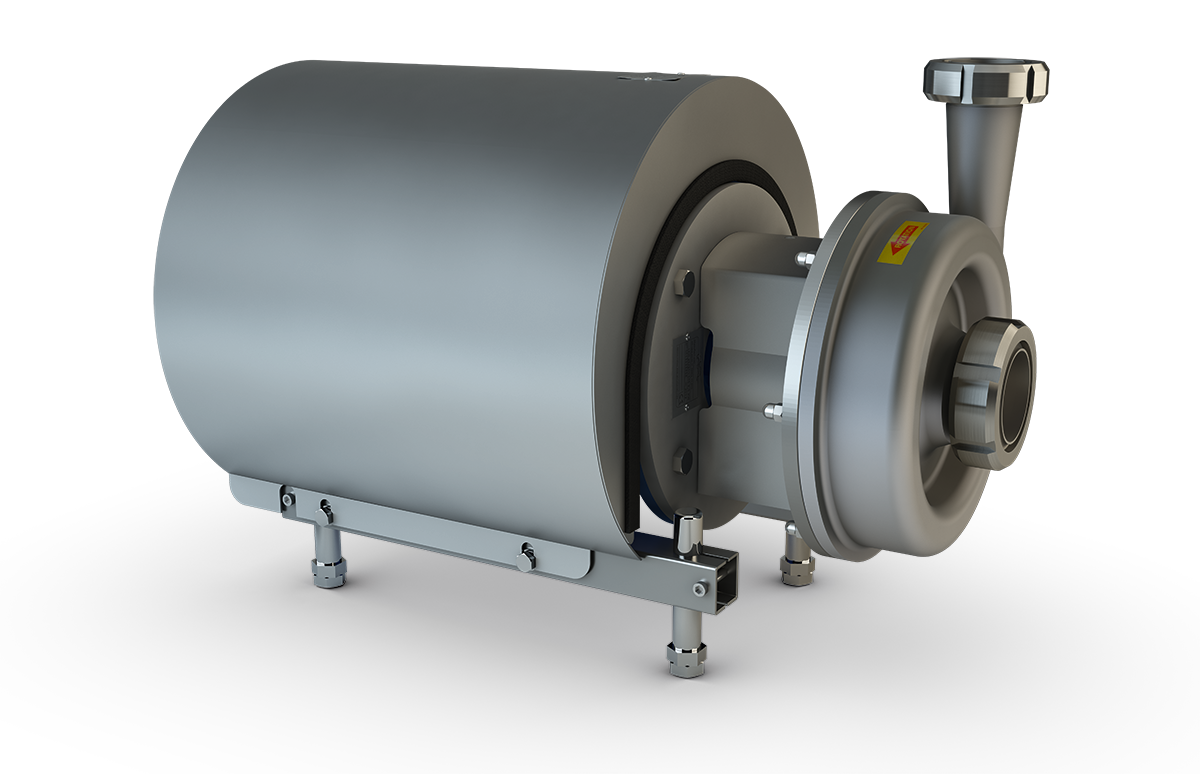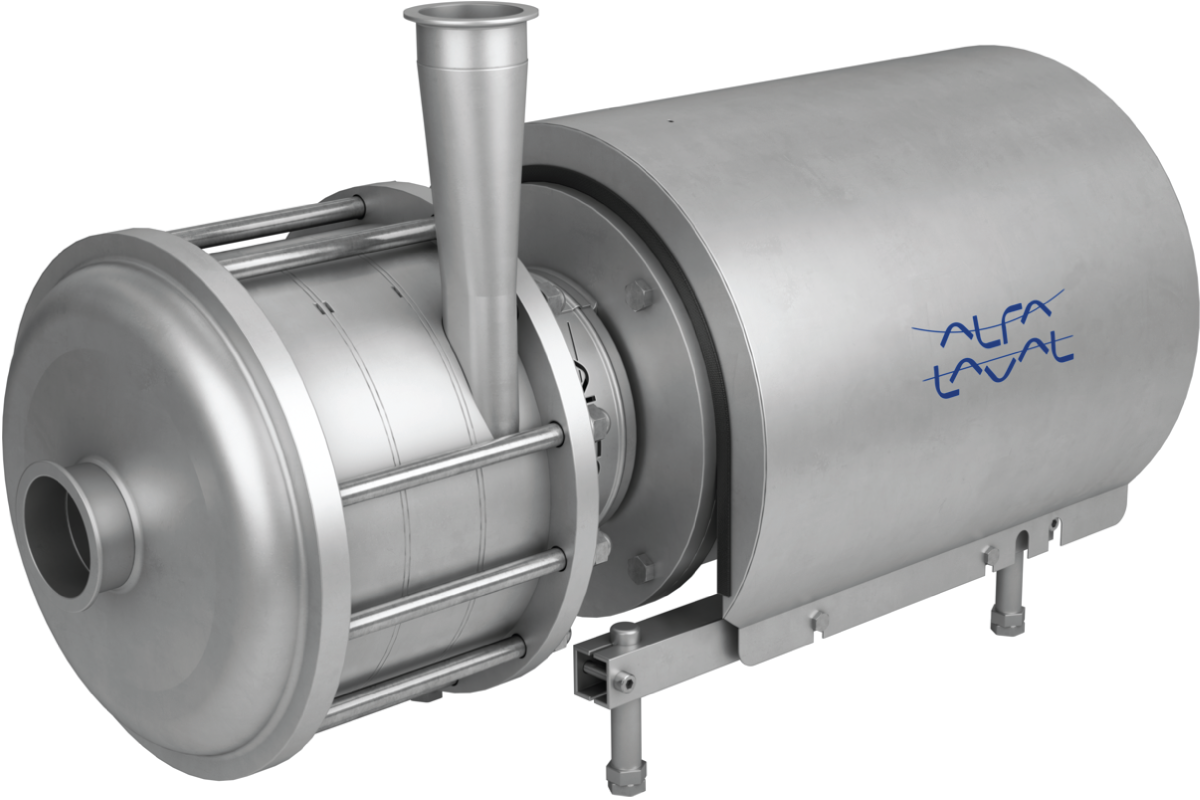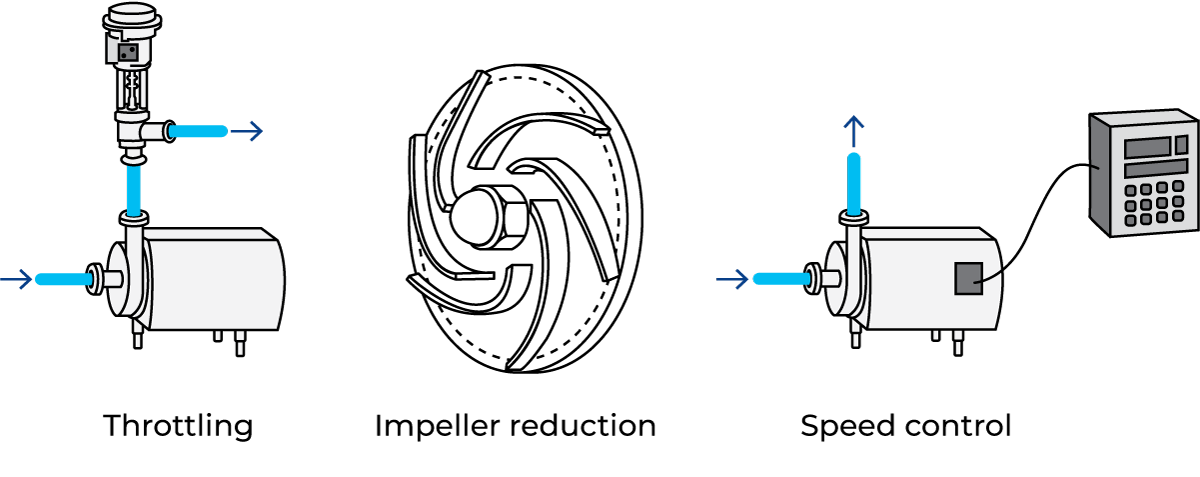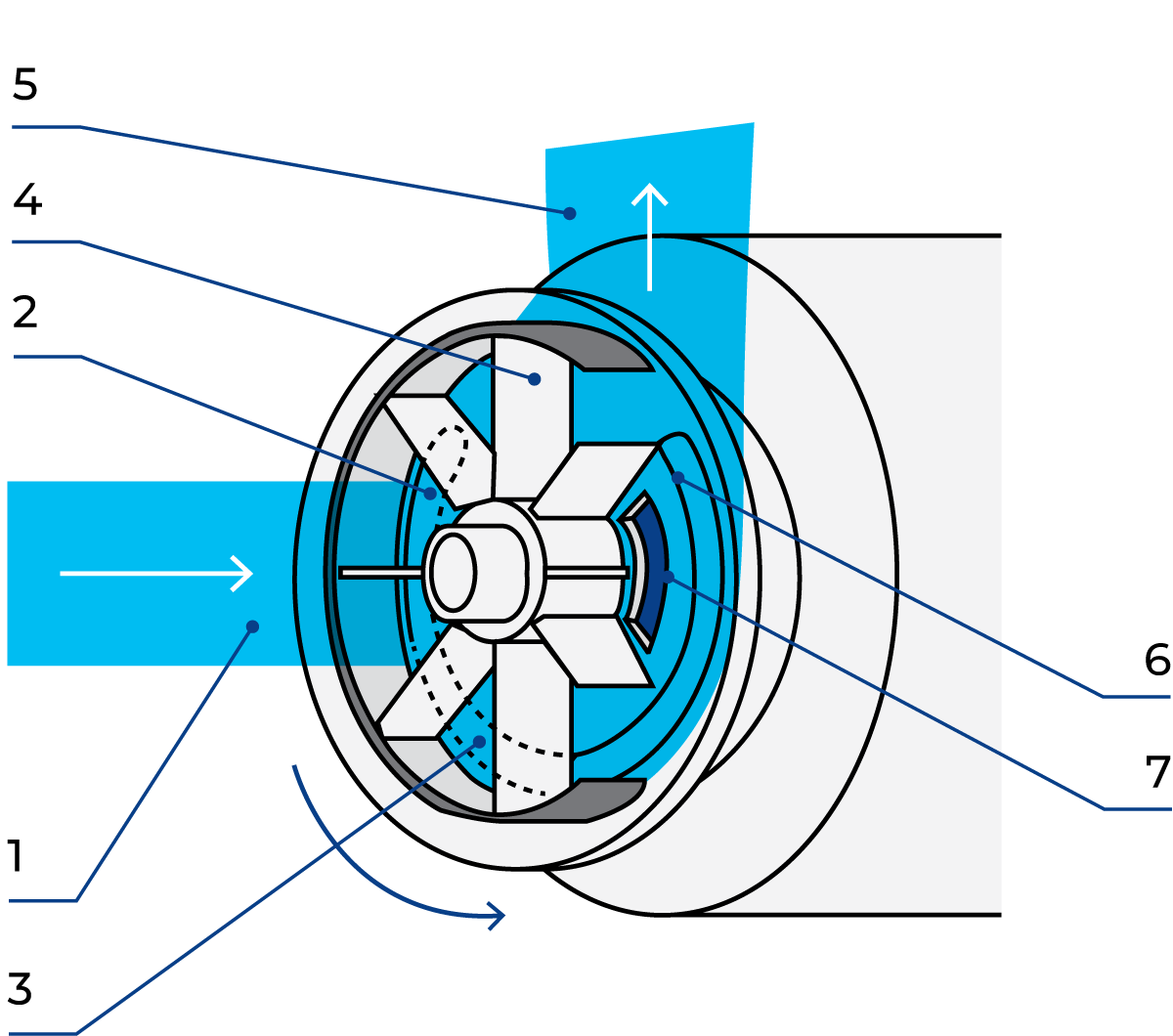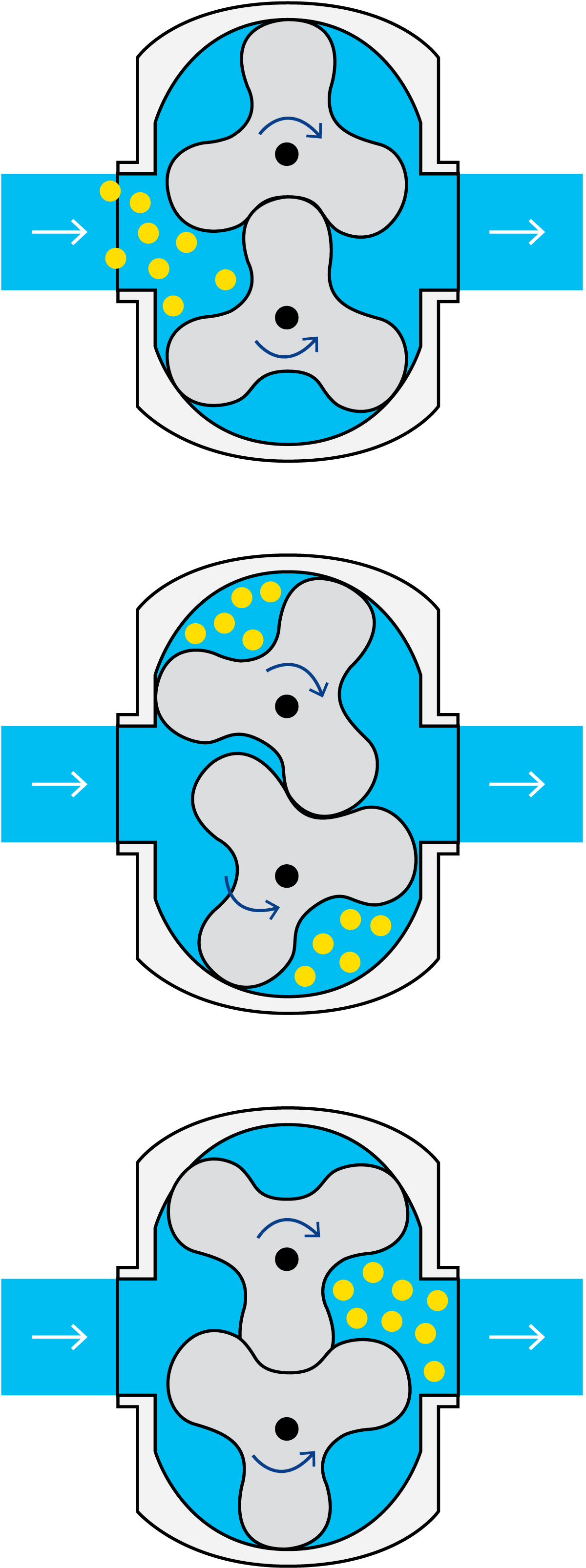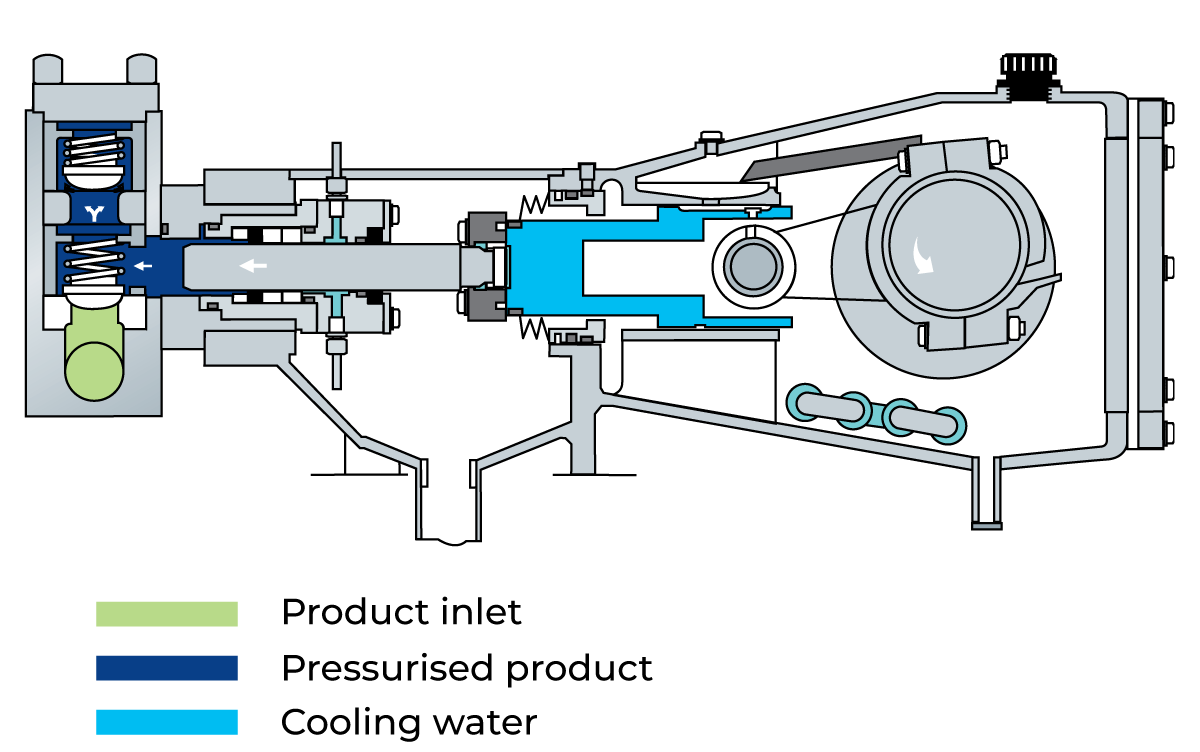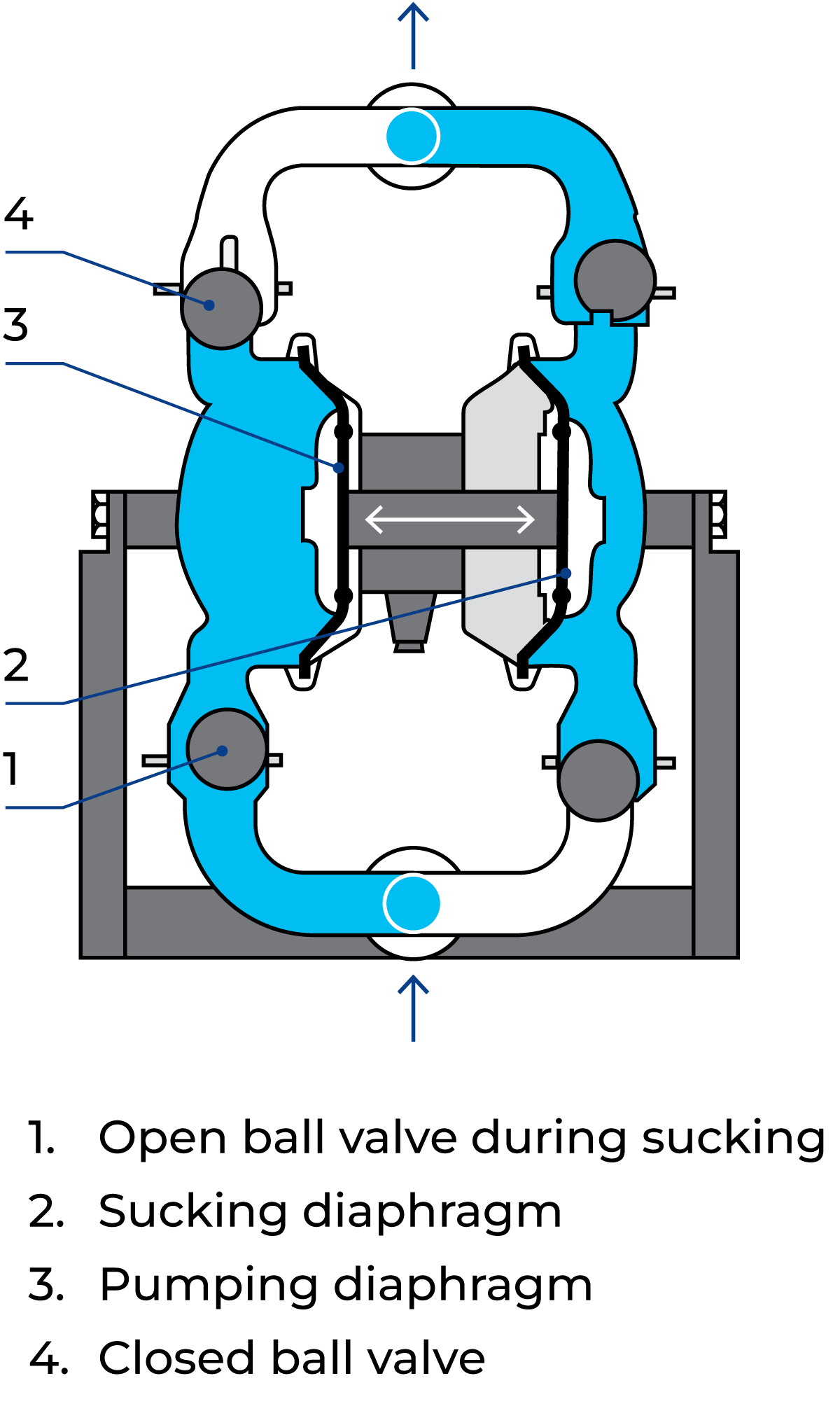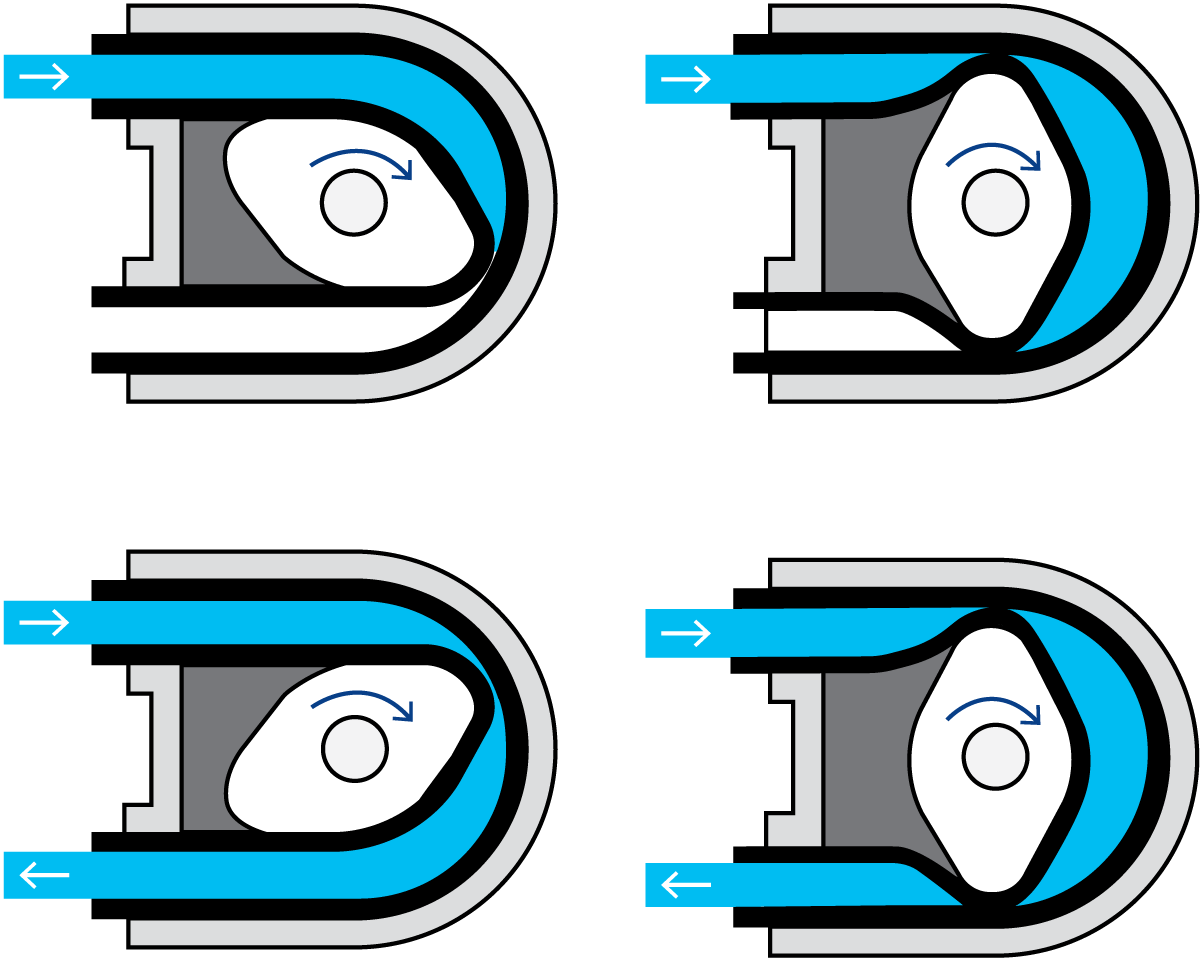Pumps
Pumping demands
Demands on the quality of products, and the profitability of manufacturing processes, have grown steadily heavier over the years. Formerly, it was often possible to allow liquids to flow through a plant by gravity. Nowadays, they are forced through long pipelines with many valves, through heat exchangers, filters and other equipment which often have high pressure drops. The flow rates are frequently high. Pumps are therefore used in numerous parts of a plant, and the need to have the right pump in the right place has become increasingly important. Many problems may arise; they can be summarised under the following headings:
- Pump installation
- Suction and delivery lines
- Type and size of pump required should be selected with regard to:
- flow rate
- product to be pumped
- viscosity
- density
- temperature
- pressure in the system
- material in the pump
Typical dairy pumps are the centrifugal, liquid-ring and positive displacement pumps. The three types have different applications. The centrifugal pump is the type most widely used in dairies.
The centrifugal pump, shown in Figures 7.8.1 and 7.8.2, is mainly used for low-viscosity products, but it cannot handle heavily-aerated liquids. The liquid-ring pump is used when the air content is high. The positive displacement pump is used for gentle treatment and high viscosities.
Suction line
Before we discuss the pumps themselves, it is important to understand the facts and problems connected with pumping.
The pump should be installed as close as possible to the tank or other source from which the liquid is to be pumped, and with as few bends and valves as possible in the suction line. This should have a large diameter in order to reduce the risk of cavitation.
Delivery line
Any throttling valve must be fitted in the delivery line, possibly together with a check valve. The throttling valve is used to adjust the flow rate of the pump. The check valve protects the pump from water hammer and prevents liquid from flowing back when the pump has stopped. Normally, the check valve is situated between the pump and the throttling valve.
Cavitation
Cavitation can be detected by a crackling sound in the pump. It occurs when the pressure drops locally below the vapour pressure and small vapour bubbles form in the liquid. The pressure increases as the liquid continues further into the impeller, and the vapour condenses very rapidly. The vapour bubbles collapse at a very high velocity and at a local pressure, which can be as high as 100 000 bar. This is repeated with a high frequency and can cause pitting damage to the surrounding material, particularly if it is brittle.
Cavitation occurs when the pressure in the suction line is too low relative to the vapour pressure of the pumped liquid. The tendency to cavitate increases when viscous or volatile liquids are pumped.
Cavitation in pumps results in reduced head and efficiency. As cavitation increases, the pump gradually stops pumping.
Cavitation should be avoided. However, should the pumping conditions be very difficult, and the pump cavitates slightly but is otherwise operating well, it is still possible to use the pump. This is because dairy pumps have impellers of acid-proof steel, which is very resistant to wear caused by cavitation. Some damage to the impeller may occur when the pump has been in operation for a long time.
The possibility of cavitation occurring in a pump can be predicted by calculation. See NPSH (Net Positive Suction Head) on the following page.
How to avoid cavitation
The general rule of thumb is:
- Low pressure drop in the suction line (large pipe diameter, short suction pipe, few valves, few bends, etc.)
- High inlet pressure to the pump, for example a high liquid level above the pump
- Low liquid temperature
Pump chart
Pump charts are invaluable for selecting a pump for a given application. Three curves are needed to select the correct pump.
- Flow rate and head, QH curve
- Required motor power, kW
- NPSH (net positive suction head)
The charts are drawn on the basis of tests with water. The data in the chart must be recalculated if liquids with other physical properties are to be pumped. The required flow rate, Q, is usually known when a pump is going to be selected. In the example shown in Figure 7.8.3, the flow rate, Q, is 15 m3/h.
The required head must usually be calculated. Here we assume 30 m.
Locate the flow rate on the bottom Q scale. Start from this point and follow a vertical line upwards until it intersects a horizontal line indicating the required head, 30 m, on the H scale. This point does not meet any of the QH curves indicating the impeller diameter. The nearest larger impeller size, in this case 160 mm, should be chosen. The resulting head will be 31 metres liquid column. The next step is to follow the vertical 15 m3/h line downwards, until it intersects the power curve for the 160 mm impeller. A horizontal line to the left of the intersection indicates a power consumption of 2.3 kW. To this figure a safety margin of approximately 15% must be added, giving a total of around 2.6 kW. Therefore, a 3 kW motor can be used.
If the pump is fitted with a motor of a certain size, always check that the motor is not overloaded. There should always be a safety margin for excess load.
Finally, the 15 m3/h vertical line is followed to the NPSH curve, to the right in the top diagram. Following the horizontal line to the right, shows that the required NPSH value is 1 metre.
Head (pressure)
When selecting a pump, it should be remembered that the head, H, in the flow chart is the head of the pump when the liquid flows into the pump without suction lift or inlet pressure.
To obtain the actual pressure after the pump, it is necessary to consider the conditions on the suction side of the pump. If there is a vacuum in the suction line, the pump must do part of its work before the liquid reaches it. The pressure at the outlet is then lower than that given in the chart.
On the other hand, if the suction line is flooded to give positive pressure at the pump inlet, the outlet pressure will be higher than that shown in the chart.
NPSH (net positive suction head)
As previously mentioned, in planning a pump installation, it is important that the suction line is laid out so that the pump does not cavitate. An NPSH curve is included in the flow charts (Figure 7.8.3). The NPSH of a pump is the necessary excess pressure above the vapour pressure of the liquid required to avoid cavitation. This is called NPSHreq.
Before this can be used, the available NPSH of the suction line in prevailing operation conditions must be calculated. This figure, NPSHav, should be equal to or higher than the required NPSH, which is the value in the chart.
The following formula is used to calculate NPSHav in the system:
pa = pressure in bar abs at the liquid surface
pv = vapour pressure in bar abs
dr = relative density
hs = static suction lift in metres liquid column
hfs = pressure drop in suction line, metres liquid column
Note that hs is negative for suction lift and positive for inlet pressure.
Shaft seals
The shaft seal is often the most sensitive component in a pump, as it must seal between a rotating part, impeller or shaft, and a stationary part, the pump casing. Normally a mechanical seal is used.
A rotating seal ring has a lapped sealing surface which rotates against a lapped stationary seal ring. A liquid film is formed between the sealing surfaces. The film lubricates the seal and prevents direct contact between the two seal rings. This means minimum wear and long life for the seal. If the pump runs dry, the lubricating liquid film in the seal is destroyed and wear on the sealing rings is increased.
The mechanical seal is usually balanced. This means that it is insensitive to the pressure in the pump. The sanitary mechanical seal needs no adjustment and causes no wear on the shaft. It is available in single or flushed versions.
Single mechanical shaft seal
Single mechanical seals, Figure 7.8.4, are standard in most sanitary pumps for the dairy industry.
In a mechanical seal the stationary seal ring is fastened to the back plate of the pump casing. The rotating ring can be fitted inside or outside the pump and is sealed with an O-ring. The rotating ring can move along the shaft and is pressed against the stationary ring by a spring.
Flushed shaft seal
The flushed seal, Figure 7.8.5, consists of two seals. Water or steam is circulated through the space between the two seals to cool or clean the seals or to create a barrier between the product and the atmosphere.
The flushed shaft seal is recommended for the following applications:
- With barrier steam for pumping sterilized products when reinfection must be avoided.
- Water flushing for pumping sticky solutions or products which crystallize, for example sugar solutions.
- Water cooling of the seal when matter may be deposited on the shaft at the seal and burn on because of the higher temperature at the sealing surfaces. An example is the booster pump in pasteurizers.
- Water barrier to exclude air from the product when pumping at a very low inlet pressure, e.g. from a vacuum vessel.
The barrier steam pressure must not exceed the atmospheric pressure at 100°C, as the steam may then become dry. This would result in the seal running dry and the sealing surfaces being damaged. The steam and water supply is regulated at the inlet to the seal, and there must be no obstructions in the outlet pipe. The barrier is always supplied through the lower connection.
Double mechanical shaft seal
The double mechanical seal, Figure 7.8.6, is similar to the flushed seal. However, the lip seal is replaced by a stationary/rotating seal arrangement similar to the single seal and the primary sealing parts of the flushed and double mechanical seals – hence the name “double mechanical”.
The double mechanical seal can be used instead of a flushed seal and is recommended for the following applications:
- As a steam barrier for pumping sterilised products to avoid possible contamination
- For cleaning of abrasive products that may damage a lip seal arrangement
- To handle aggressive flushing fluids, such as those used in certain pharmaceutical or chemical processes, as these may damage a lip seal arrangement
- As a high-pressure flushing barrier (up to 5 bar) if a lip seal arrangement is not suitable
Internal shaft seal
Most pumps have external shaft seals, as the design is simple and they are the optimum solution from a hygienic point of view. The external seal is suitable for most applications.
For the external seal, the processed product is located inside the seal and product pressure forces the product out between the seal faces. This means that the external seal has a limitation regarding maximal product pressure, typically 10 bar.
Therefore, high inlet pressure and multi-stage centrifugal pumps need an internal shaft seal.
For the internal seal, the processed product is outside, surrounding the seal. This principle, together with heavy-duty designed seal parts, means that the internal seal can handle inlet pressures of up to 40 bar, see Figure 7.8.7.
The internal seal is available as a single seal or a flushed seal. Handling and suitability of the flushed seal is the same as for the external flushed seal.
Material for shaft seals
A commonly used combination of materials is carbon for the rotating seal ring and stainless steel for the stationary ring. A better combination is silicon carbide against carbon. For abrasive liquids, seals with very hard faces are recommended. Silicon carbide against silicon carbide is commonly used for such applications.
Centrifugal pumps
Pumping principle
The liquid entering the pump is directed to the centre (eye) of the impeller and is set in circular motion by the impeller vanes, as in Figure 7.8.8. As a result of the centrifugal force and the impeller motion, the liquid leaves the impeller at a higher pressure and velocity than at the impeller eye. The velocity is partly converted into pressure in the pump casing before the liquid leaves the pump through the outlet connection.
The impeller vanes form channels in the pump. The vanes are normally curved backward, but may be straight in small pumps.
Centrifugal pump types
Different types of centrifugal pump are available, depending on the application requirements.
These types are:
- Standard centrifugal pump
- High inlet pressure centrifugal pump
- Multi-stage centrifugal pump
- Self-priming centrifugal pump
Standard centrifugal pump
This is the cheapest and most commonly used centrifugal pump, as it is suitable for most non-viscous applications.
The standard pump has some limitations regarding high inlet and system pressures, as well as aerated applications. In these cases other centrifugal pump types should be used.
High inlet pressure centrifugal pump
This pump is specially designed for applications with high inlet pressure requirements, such as filtration systems.
The special-purpose parts in this pump are a specialized motor, heavy-walled pump casing, thick backplate and a hygienic internal mechanical shaft seal to withstand the high inlet pressure, Figure 7.8.9.
Multi-stage centrifugal pump
This pump is specially designed for high outlet pressure requirements at relatively low capacities. Pumps of this type are typically used as booster pumps.
The pump consists of several stages and it works in a similar way to several pumps coupled in series.
Its special-purpose pump design includes several impellers and intermediate casings, thick backplate and a hygienic internal mechanical shaft seal, Figure 7.8.10.
The motor is either standard or special purpose, depending on the level of inlet pressure.
Self-priming centrifugal pump
This self-priming pump is specially designed for aerated applications, such as CIP return systems.
The pump is a standard centrifugal pump that is equipped with a canister with an air screw.
If it is only pumping fluids, the pump works as a normal centrifugal pump. However, if air/gases enter the pump, the eccentric position of the canister relative to the airscrew, an air chamber forms between the liquid ring and the airscrew, which separates into air pockets between the air-screw vanes.
Centrifugal pump applications
The centrifugal pump is the most commonly used pump in the dairy industry and should be selected if it is suitable for the application in question. The reason for this is that a centrifugal pump is usually cheaper to purchase, operate and maintain, and is also the most adaptable pump for different operating conditions. The centrifugal pump can be used for pumping of all liquids of relatively low viscosity which do not require particularly gentle treatment. It can also be used for liquids containing relatively large particles, provided of course that
the particle size does not exceed the dimensions of the impeller channel.
A disadvantage of the centrifugal pump is that it cannot pump aerated liquids; it loses prime and stops pumping. It must then be stopped and primed – filled with liquid – and started again before it can continue pumping. Consequently, the centrifugal pump is not self-priming and the suction line and pump casing must be filled with liquid before it can operate. The installation should therefore be carefully planned.
Flow control
It is seldom possible to select a standard pump that fits the required capacity exactly. Some sort of adaptation must therefore be made by:
- throttling – highly flexible but uneconomical
- reducing the impeller diameter – less flexible but more economical
- speed control – flexible and economical
The three alternatives are illustrated in Figure 7.8.12.
Throttling
The most simple flow control is to fit a throttling valve in the pump outlet line. It is then possible to adjust the pump exactly to the required pressure and flow rate. This is the correct method if the pump is used for varying pressures and flow rates. The disadvantage is that throttling is uneconomical when pressure and flow are constant.
Throttling can be carried out with orifice plates in the pipe, with manual or automatic control valves or with a mechanical flow controller, which is often fitted in milk treatment lines.
Reducing impeller diameter
A lower pump curve than the maximum curve is obtained by reducing the original impeller diameter D to D1 (Figure 7.8.13). The new diameter D1 can be roughly determined by drawing a straight line from O on the chart through the required operating point A to the standard curve B, for impeller diameter D. Read pressure H and the required new pressure H1. The new impeller diameter D1 is obtained from the formula:
The most economical pump installation is obtained if the impeller diameter is reduced to diameter D1. Most pump charts have curves for different impeller diameters.
Speed control
Changing the speed will change the centrifugal force created by the impeller. Pressure and capacity will then also change – up for higher speed and down for lower.
Speed control is the most efficient way of regulating a pump. The speed of the impeller is always exactly right for the performance of the pump, and therefore also the power consumption and the treatment of the liquid.
A frequency converter can be used, together with standard three-phase motors. They are available for manual or automatic control of flow and pressure.
Pumps for 60 Hz
Most centrifugal pumps are designed for 50 Hz, which means 3 000 rpm (revolutions per minute) for a two-pole motor. The power supplies in some countries operate at 60 Hz, which means that the speed increases by 20% to 3 600 rpm. Pump curves for 60 Hz are available from pump manufacturers.
Head and pressure
Density
The head in metres liquid column is independent of the density of the liquid being pumped. However, the density is of great importance to the discharge pressure and for the power consumption.
If the pump and the viscosity of the liquid are the same in the different cases, the liquid column will be lifted to the same height (10 metres in the example), regardless of the density. The pump head in metres liquid column is the same. However, as the density – the mass of the liquid – varies, the pressure gauge readings will also vary (Figure 7.8.14).
The pump pressure in metres water column is consequently obtained if the pressure in metres liquid column is multiplied by the relative density.
The pump must do more work with the heavier liquid than with the lighter. The power required changes proportionally to the density. If, in example A, the figure requires 1 kW, then example B will require 1.2 kW and example C only 0.8 kW.
Note:
In the pump flow charts, the head is always in metres liquid column and the power consumption for water with density 1.0. This means that for pumping liquids of higher density, the power in the curve must be multiplied by the density.
Viscosity
Liquids of higher viscosity create higher resistance to flow than liquids of lower viscosity. When liquids of higher viscosity are pumped, the flow rate and head are reduced and power demand increases because of increased flow resistance in the impeller and pump casing.
Centrifugal pumps can handle liquids of relatively high viscosities, but are not recommended for viscosities much above 500 cP, because the power demand rises sharply above that level.
Liquid-ring pumps
Liquid-ring pumps (Figure 7.8.15) are self-priming if the casings are at least half-filled with liquid. They can then handle liquids with a high gas or air content. The pump consists of an impeller with straight radial vanes (4) rotating in a casing, an inlet, an outlet and a drive motor. From the inlet (1), the liquid is led between the vanes and accelerated out towards the pump casing, where it forms a liquid ring with essentially the same speed of rotation as the impeller. There is a channel in the wall of the casing. It is shallow at (2) and becomes progressively deeper and wider as it approaches (3) and then gradually becomes shallow again to point (6). As the liquid is transported by the vanes, the channel is also filled, increasing the volume available for the liquid between the vanes. This results in a vacuum in the centre, which causes more liquid to be drawn into the space from the suction line.
The deep channel (3) has been passed, the volume between the vanes is reduced as the channel becomes shallower. This gradually forces the liquid towards the centre and increases the pressure and liquid is discharged through port (7) to pump outlet (5).
Air in the suction line will be pumped in the same way as the liquid.
Applications
Liquid-ring pumps for the dairy industry are used where the product contains large quantities of air or gas, and where centrifugal pumps therefore cannot be used. The clearances between impeller and casing are small, and this type of pump is therefore not suitable for handling abrasive products.
A common application is as a CIP return pump for cleaning solution after a tank, as the CIP solution contains normally large amounts of air.
Positive displacement pumps
Pumping principle
This group of pumps works on the positive displacement principle. They are divided into two main categories: rotary pumps and reciprocating pumps. Each category includes several types.
The principle of a positive displacement pump is that for each revolution or each reciprocating movement, a definite net amount of liquid is pumped, regardless of manometric head, H.
However, at lower viscosities there may be some slip (internal leakage) as the pressure increases. This will reduce the flow per revolution or stroke. The slip is reduced with increased viscosity.
Throttling the outlet of a positive displacement pump will increase the pressure dramatically. It is therefore important that:
1. No valve after the pump can be closed
2. The pump is fitted with a pressure-relief valve, built into the pump or as a bypass valve.
Flow control
The flow of a positive displacement pump is normally controlled by regulating the speed. Adjustment of the stroke of a reciprocating pump is another possibility.
Pipe dimensions and lengths
Great care must be taken in dimensioning the pipework when high-viscosity products are pumped. The pumps must then be placed close to the feeding product tank and the pipe dimensions must be large. Otherwise the pressure drop will be so high that the pump will cavitate.
The same applies to the outlet side. The pressure will be very high if the pipes are long and narrow.
Lobe-rotor pumps
The lobe-rotor pump has two rotors, usually with 2 – 4 lobes each. A vacuum is created at the inlet when the rotors rotate. This vacuum draws the liquid into the pump. It is then moved along the periphery of the pump casing to the outlet. There, the volume is reduced and the liquid forced out through the outlet. The course of events is illustrated in Figure 7.8.16.
The rotors are independently driven by a timing gear at the back of the pump. The rotors do not touch each other or the pump casing, but the clearances between all parts in the pump are very narrow
Applications
This type of pump has 100% volumetric efficiency (no slip) when the viscosity exceeds approximately 300 cP. Because of the sanitary design and the gentle treatment of the product, this type of pump is widely used for pumping cream with a high fat content, cultured milk products, curd/whey mixtures, etc.
Circumpherential piston pump
The design is suited to applications that are low in viscosity with medium to high discharge pressures and require equipment that can be cleaned in place. Twin-wing piston rotors made of special non-galling alloy are standard. All other media contacting steel components, like the rotor case, front cover and rotor nuts are in W. 1.4404 (AISI 316L). The rotor pistons rotate around the circumference of the channel in the pump casing. This continuously generates a partial vacuum at the suction port as the rotors unmesh, causing fluid to enter the pump. The fluid is transported around the channel by the rotor pistons, and is displaced as the rotor pistons re-mesh, generating pressure at the discharge port. The direction of flow is reversible.
Twin Screw Pumps
The Twin Screw Pump combines process duties typically handled by positive displacement with Cleaning-in-Place (CIP) duties typically handled by centrifugal pumps. This provides a robust and reliable platform that offers greater process flexibility. It is capable of handling both product transfer and CIP. Its low pulsation characteristics and excellent solids-handling capability reduce the risk of product damage, thereby improving product quality. Designed for handling sensitive, abrasive and high and low viscosity fluids, the twin screw pump is ideal for use in hygienic applications across the dairy, food, and beverage industries. The twin screw pump is a positive displacement pump. As the pump rotates, the intermeshing of the two contra-rotating screws, along with the pump casing, form volumetric chambers. These chambers fill with the pumped fluid and move the fluid axially from the suction side of the pump to the higher pressure discharge side.
Eccentric-screw pumps
This pump is tighter than the lobe rotor pump for lower viscosity products. It is not considered quite as hygienic as the lobe-rotor pump, but handles the pumped product gently. The range of application is the same as that of the lobe-rotor pump.
The eccentric-screw pump (Figure 7.8.18) cannot be run dry, even for a few seconds, without being damaged.
Piston pumps
A piston pump normally has 1, 2, 3 or 5 pistons, Figure 7.8.19. A rotating crankshaft drives the pistons backwards and forwards via a piston rod. Check valves on both the suction- and pressure side regulate the flow in the right direction.
5-piston pump gives a less pulsating flow than a 3-piston one.
Piston pumps are normally used when high pressure and low energy consumption are required. The high-pressure homogenizer is an example of a piston pump followed by a homogenizing device.
Volumetric efficiency is also close to 100% at low viscosity and varying back pressure. A piston pump can therefore be used as an accurate metering pump. The capacity is proportional to the crankshaft speed.
For metering purposes, a special type of piston pump can be used. The capacity of each piston is adjusted via its stroke length. This type of pump is used when several different components are mixed in given proportions. Each piston handles one component.
Dosing pumps
Diaphragm pumps
Air-powered diaphragm pumps, one of which is illustrated in Figure 7.8.20, are used for gentle treatment of the product. There are pulsations in the outlet pressure and the capacity will change with changing product pressures, as the air pressure is constant. These pumps are therefore mainly used to transport products and not used very often within the processes themselves. Mechanically powered diaphragm pumps are often used as metering pumps.
Working principle
Diaphragm pumps are double-acting positive displacement pumps with two alternating pump chambers. The compressed air required for driving the unit is admitted through a control valve to the rear of each diaphragm in turn. This displaces the medium from alternate pump chambers.
The diaphragm has the additional function of separating the pumped product from the compressed air. Since the same pressure prevails in both the compressed air and pumping chambers during each stroke, the diaphragms themselves are not subjected to pressure differences. This is one reason for the long life of the diaphragms.
A vacuum is created by the retraction of the diaphragm, and the pumped product flows into the chamber. The volume in the opposite chamber is simultaneously reduced, and the product is discharged through the outlet check valve.
The two diaphragms are connected with a common piston rod, and suction therefore always occurs in one chamber while product is discharged from the other. The compressed air serves a dual purpose during each phase: the actual discharge process and the intake of further medium to be conveyed.
Peristaltic pumps (hose pumps)
This type of pump (Figure 7.8.21) can be used for transportation as well as for relatively accurate metering of products.
The rotor rotates in the lubricant-filled pump housing and compresses the hose with the rollers. The suction and discharge sides are hermetically sealed from each other.
During rotation, the medium (liquid or gas) inside the hose is transported to the lower outlet connection. This creates a vacuum on the suction side, and the product is drawn into the pump. The pump is self-priming and is therefore suitable for emptying barrels with juice concentrates and anhydrous milk fat (AMF).
The volume between the rollers is equal to half the volume transported per rotation. This amount is constantly pumped to the outlet connection during rotation, while the same amount is drawn in on the suction side.
